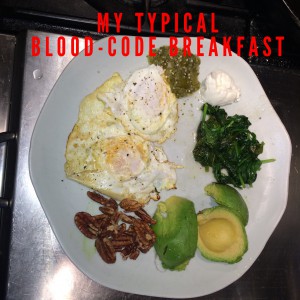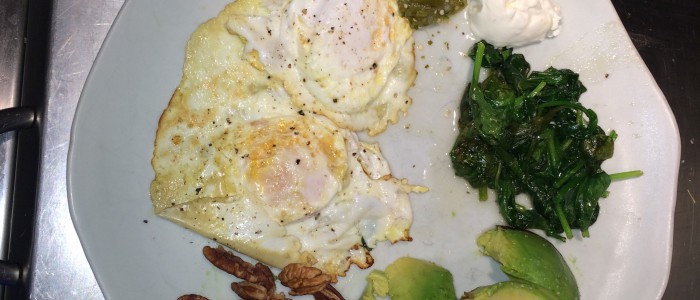BREAKFAST – for your lower carb – higher fat Blood Code diet
There is talk of insulin levels below. If you don’t know yours: get it tested with a fasting PROGRESS PANEL. You can get this anywhere in the US through this link
Many people are not very hungry at breakfast time, yet studies repeatedly show that those who eat breakfast have better blood sugar control and concentration and mood throughout the day. So what’s the scoop?
A burst of adrenaline and cortisol occurs as you wake from sleeping; in part, this is to prepare you for the most stressful part of your day: getting out of bed. It is also to generate some body heat, since it is normal for your temperature to drop 1 to 2 degrees overnight while sleeping. All of this neurochemical stimulation in your body—called the dawn phenomenon—raises your blood sugar and lowers your appetite. With this in mind, you can understand why you need a lower carb intake at breakfast compared to your other meals.
Your first meal needs to be designed to repair and replace the tissue lost during the prior ten- to twelve-hour fast. This means you need to eat a smart meal in the morning. It doesn’t need to be a lot if you aren’t hungry, but it needs to be something.
Here are three basic breakfasts, all of which can be modified to fit your time frame and cuisine preferences. Even those with no insulin resistance should limit carbs to 30 to 40 grams at the first meal of the day. For reference, a banana and bowl of granola is over 60 grams of carb.
 Breakfast #1: Eggs and Veggies
Breakfast #1: Eggs and Veggies
What: Two eggs, any dark leafy greens, fat of your choice, and a piece of toast that matches your carb tolerance.
How: Put your fat of choice into a pan (olive oil, butter, or a high-quality rendered animal fat). Cook the eggs the way you like, ensuring that there’s enough fat to sauté the greens in the same pan. Salt to taste. Toast a tolerable amount of bread and butter it well.
Carb count: About 2 grams for the greens; half a piece of toast has 6 to 12 grams of carb; 0 grams for eggs and dietary fats.
Calorie talk: Eggs have 180 calories; 20 for greens; 40 to 50 for toast. Each Tbsp of butter or olive oil has 90 to 100 calories, so add 2 Tbsp of dietary fats to bring your breakfast to a satisfying 400 to 450 calories. Let’s say your daily goal is about 2,000 calories; you are getting only 20 percent of your calories with this breakfast, so, as expected, it is your smallest meal of the day.
Bread substitute: Oven-roasted veggies (a hearty mix of carrots, parsnips, cauliflower, onions, and garlic—even potatoes, if you can tolerate more carbs) can be roasted ahead of time with ample olive oil and butter and reheated as needed. They are even good cold. A sprinkle of Parmesan cheese adds a lot of flavor. A good 3-ounce serving will be only 5 to 10 grams of carb, and it offers far more nutrition than bread.
Breakfast #2: Dairy-Based
A word of caution here: IF your insulin is high (>8 on a fasting insulin), dairy as a main course will raise your insulin so much that you will store the meal swiftly. Meaning, your triglyceride will go up and your body fat might stubbornly go up. For the lean and individuals with low TG, diary works. If you are big enough as you are, choose the other breakfast options to keep your insulin lower after the meal.
What: 4 ounces whole-fat, plain yogurt,* ten to twelve almonds, cashews, or pecans
How: No further preparation required.
Carb count: About 7 grams for the yogurt, 1 for the nuts.
Calorie talk: The yogurt has 80 calories, the nuts, 100. This is a snack-like breakfast with only 200 calories, or one-tenth of a 2,000-calorie diet. This is a very small breakfast on its own.
Yogurt substitute: Cottage cheese for yogurt for lower carb and higher protein, this due to the addition of dry milk solids in the cottage cheese. You might also add a hard-boiled egg and greens to this meal for extra calories and no extra carbs.
* You can easily make your own yogurt, as I do; I also add extra cream into the milk before heating/cooling and pitching the yogurt starter. This makes a higher-fat and lower-carb food for half the cost of yogurt.
Breakfast #3: Meat-Based
I grew up with some Italian cuisine, and I recall that it was always a big deal during Lent to give up meat for one day per week, Friday. Generations ago, my Italian ancestors probably had some meat at nearly every meal, so to avoid meat (and eat only fish, not considered meat) for a full twenty-four hours was considered a worthy sacrifice within the Catholic community. (Sicily has a disproportionate number of people over a hundred years old, and, as with other parts of the world, it appears as though this is partially diet-related.)
How far we have come. Maybe it’s time to bring some nutrient-dense meat back to breakfast, especially if you are active and require significant carb restriction.
Quebecois French: Two Wasa (or similar) crackers with spreadable pâté. In our area of Maine, cretons (pronounced “creh-tohn”) is a spreadable pork pâté that makes a good breakfast or predinner snack.
Any leftovers from dinner: Pork, chicken, beef, fish—sauté a little meat in some olive oil and add whatever greens you have on hand. If fresh veggies are hard to come by, prewashed spinach, kale, or other cooking greens are available in nearly every food market. Eat with toast or the roasted veggies listed in Breakfast #1.
Carb count: None for the meat or pâté; the greens are about 2 grams per cup of cooked greens, so the cracker, bread, or roasted root veggies are the only carbs that need to be counted.
Calorie talk: Meats are dense; this means they have more nutrition and more calories per forkful, which is desirable when you need to get enough sustenance without feeling full.
Substitutions: The options are endless. Many people at my office have successfully reversed their diabetes by eating nontraditional meals at breakfast, like chicken soup or meat and veggie leftovers. This is an effective way to avoid the unfortunately popular grains, fruit, and sugar that dominate even the “healthy choice” boxed cereal breakfasts.




Comments are closed.